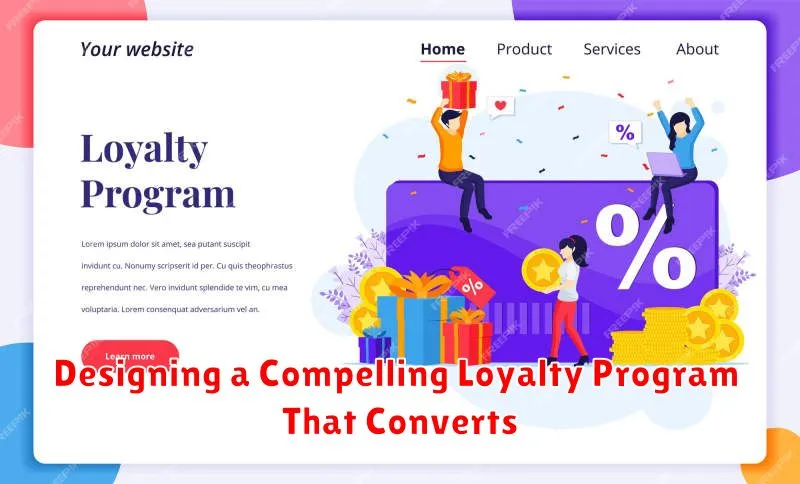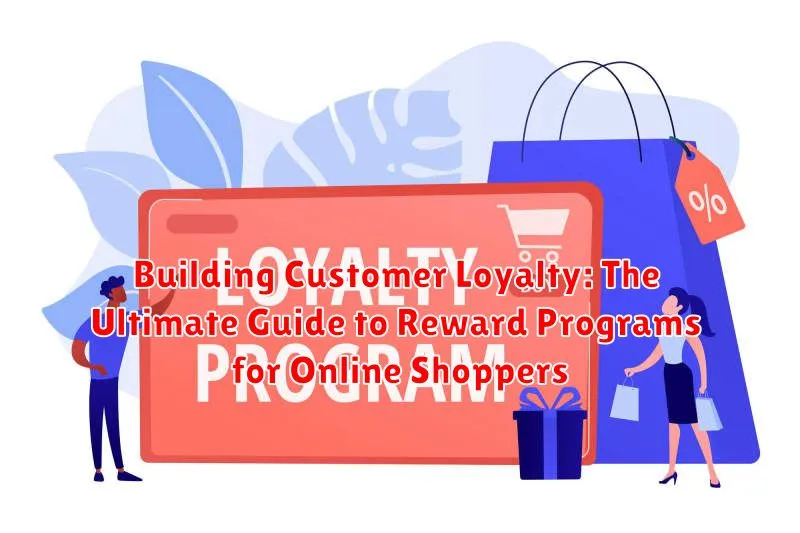In today’s competitive e-commerce landscape, customer loyalty is more crucial than ever. Attracting new customers is essential, but retaining existing ones is the key to sustainable growth and profitability. This ultimate guide explores the power of reward programs, providing actionable strategies for online retailers to cultivate lasting relationships with their online shoppers. Learn how to design a customer loyalty program that not only incentivizes repeat purchases but also fosters a genuine sense of community and appreciation.
This comprehensive guide delves into the intricacies of building a successful reward program tailored specifically for the nuances of online shopping. We’ll cover key aspects such as choosing the right reward program structure, selecting compelling rewards, leveraging technology to personalize the customer experience, and measuring the effectiveness of your customer loyalty initiatives. Whether you’re just starting out or looking to revamp your existing customer loyalty program for online shoppers, this guide offers valuable insights to maximize customer engagement and boost your bottom line.
Why Customer Loyalty Matters in the E-Commerce Landscape
In the competitive world of e-commerce, attracting new customers can be costly and time-consuming. Cultivating customer loyalty, however, offers a powerful advantage.
Loyal customers are more likely to make repeat purchases, increasing your customer lifetime value. They also tend to spend more per transaction than new customers. This consistent revenue stream contributes significantly to stable growth and profitability.
Beyond direct sales, loyal customers become brand advocates. They often recommend your products or services to their networks, providing valuable word-of-mouth marketing. This organic promotion can be more effective and less expensive than traditional advertising.
Finally, loyal customers offer valuable feedback and insights. They can help you identify areas for improvement in your products, services, and overall customer experience, ultimately contributing to the ongoing evolution and success of your business.
Types of Loyalty Programs: Finding the Perfect Fit for Your Business
Choosing the right loyalty program structure is crucial for its success. Different models cater to various business needs and customer preferences. Here are some popular options:
Points-Based Systems
These programs reward customers with points for every purchase, which can later be redeemed for discounts, free products, or exclusive perks. Flexibility and simplicity make points programs a popular choice.
Tiered Programs
Tiered programs offer escalating benefits as customers spend more. This structure encourages increased spending and fosters a sense of exclusivity for high-value customers.
Paid Membership Programs (VIP)
Customers pay a recurring fee for exclusive benefits like free shipping, early access to sales, and dedicated customer support. VIP programs generate consistent revenue and cater to highly engaged customers.
Value-Based Programs
These programs focus on rewarding customers based on shared values, such as donations to charity or sustainable practices. This model attracts customers aligned with the brand’s mission and fosters a strong emotional connection.
Designing a Compelling Loyalty Program That Converts

A well-designed loyalty program is key to attracting and retaining customers. Simplicity is paramount. A convoluted program will deter participation. Clearly outline how points are earned, redeemed, and the associated benefits.
Tiered programs can incentivize higher spending. Offer increasing rewards and perks as customers move up the tiers. Consider exclusive discounts, early access to sales, or personalized customer service.
Experiential rewards, such as birthday discounts or early access to new products, can foster a deeper connection with your brand. These rewards often resonate more than simple monetary discounts.
Finally, don’t underestimate the power of choice. Allowing customers to choose their rewards, whether it’s a discount, free gift, or donation to a chosen charity, adds a level of personalization that enhances the program’s appeal.
Implementing Your Loyalty Program on Your Online Store Platform
Successfully integrating your loyalty program into your e-commerce platform is crucial for a seamless customer experience. The implementation process will vary depending on your chosen platform and the complexity of your program.
Platform Compatibility: Ensure your chosen loyalty software is compatible with your e-commerce platform. Many platforms offer integrations with popular loyalty program providers. If not, custom development might be necessary.
Plugin Installations: Numerous plugins and extensions simplify the integration process. These tools often provide pre-built functionalities like point tracking, reward redemption, and tier management. Carefully evaluate the features and reviews of different plugins before selecting one.
API Integrations: For more complex programs or custom-built platforms, using APIs offers greater flexibility and control. APIs allow seamless data exchange between your loyalty program and your e-commerce platform, ensuring accurate tracking and personalized experiences.
Testing and Refinement: Thoroughly test the integration before launching it to your customers. Check for any glitches in point accrual, reward redemption, and tier progression. Gather feedback from a small group of users to identify and address any issues.
Promoting Your Loyalty Program to Drive Enrollment and Engagement
Once your loyalty program is set up, effective promotion is crucial for driving enrollment and engagement. A multi-pronged approach is often the most effective.
Website Promotion
Promote the program prominently on your website. Use banners, pop-ups (judiciously), and dedicated sections to highlight the benefits and encourage sign-ups. Integrate the loyalty program information into the checkout process.
Email Marketing
Leverage email marketing to reach existing customers and inform them about the new program. Send targeted campaigns explaining the benefits and encouraging them to join. Include clear calls to action in your emails.
Social Media Engagement
Use social media platforms to generate excitement and awareness. Run contests and giveaways exclusive to loyalty program members. Encourage user-generated content related to the program. Highlight member testimonials and success stories.
In-Package Promotions
Include information about your loyalty program in physical shipments. Insert flyers or small cards detailing the benefits and providing a QR code for easy signup.
Partnerships and Cross-Promotions
Consider collaborating with complementary businesses to cross-promote your loyalty program. This can expand your reach and introduce your program to a new audience.
Measuring the ROI of Your Customer Loyalty Program
Accurately measuring the return on investment (ROI) of your loyalty program is crucial to understanding its effectiveness and making data-driven decisions. It’s not just about counting members; it’s about understanding their value.
A key metric is customer lifetime value (CLTV). Compare the CLTV of loyalty program members to non-members. A higher CLTV for members demonstrates the program’s positive impact.
Track redemption rates and the associated costs. This helps optimize reward offerings and ensure profitability. Also, monitor program participation rates. A low participation rate may indicate a need for program adjustments.
Analyze customer retention rates. A successful loyalty program should improve customer retention. Finally, consider surveying members to gather qualitative feedback on program satisfaction and areas for improvement. This provides valuable insights beyond numerical data.
Best Practices for Maintaining a Thriving Loyalty Program

Maintaining a successful loyalty program requires ongoing effort and optimization. Regularly evaluate program performance using key metrics like customer retention rate, redemption rates, and customer lifetime value.
Personalization is key. Tailor rewards and communication based on individual customer preferences and purchase history. This makes members feel valued and appreciated.
Keep the program simple and easy to understand. Complicated tiers and redemption processes can deter participation. Transparency in earning and redeeming points is crucial.
Promote your loyalty program actively. Regularly remind customers of their benefits and exclusive offers. Use various channels like email marketing, website banners, and social media.
Offer a variety of rewards to cater to different customer preferences. This could include discounts, free shipping, exclusive access to sales, or experiential rewards.
Common Mistakes to Avoid in Loyalty Program Management
A successful loyalty program requires careful planning and execution. Avoiding common pitfalls can significantly impact its effectiveness. Here are some key mistakes to steer clear of:
Making Rewards Too Difficult to Earn
Complicated earning structures or unrealistic spending thresholds can discourage participation. Keep the process straightforward and attainable to motivate engagement.
Lack of Program Promotion
Don’t assume customers will automatically discover your program. Actively promote it across various channels, including your website, email marketing, and social media platforms.
Ignoring Customer Feedback
Regularly solicit and analyze customer feedback. Understanding their needs and preferences is crucial for program optimization and ensuring its ongoing relevance.
Static Reward Options
Offering the same rewards over time can lead to program fatigue. Introduce variety and exclusive perks to keep customers engaged and excited.
Poor Communication
Maintain consistent communication with program members. Keep them informed about program updates, new rewards, and exclusive offers. Transparency builds trust and encourages participation.

